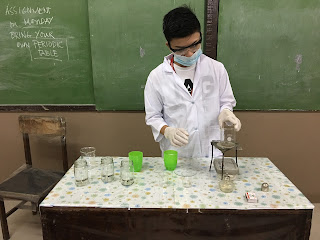Science is a
Continuous Search for Knowledge
Science comes from the Latin word Scientia
(scient, sciens), which means “having knowledge.” A scientist once said,
“Science is an observation followed by experimentation leading to further observations
and followed again by further experimentations.”
For example, from the idea of the
four-dimensional universe, Albert Einstein developed his Law of Relativity.
Then other scientists made use of Einstein’s theory to explore the atom. In the
1930’s, it was discovered that an atom could be split, producing a large
quantity of energy. In the 1940’s, practical atomic reactors were built. Today,
we have power plants that make use of atomic energy. Almost all the physical
laws concerning the universe were discovered in the middle of the sixteenth
century, the Age of Modern Science. It all began with very few ideas. Those few
ideas have grown, and they continue to grow and develop. New ideas lead to new
discoveries that fuel more new ideas and discoveries.
Today, we know that the neutrons, protons,
and electrons are no longer the smallest particles that make up objects because
scientists have discovered smaller particles in 1977 that they named as quarks.
Science
as a Product and a Process
Science is ….
1. an ongoing process of investigating and
thinking;
2. a way of thinking which involves
reasoning; and
3. a way of investigating which involves
questions, observations,
experimentations, and predictions.
experimentations, and predictions.
Branches
of Science
1.
Social science
– focuses primarily on the study of people, culture, and their societies.
Branches of Social
Science
a. Economics e. Law
b. Geography f. Education
c. History g. Sociology
d.
Psychology
2.
Natural science
– seeks to understand the natural world and its different processes
Natural Science is divided into...
a. Pure science – is used in
pursuit of new knowledge. It deals with new discoveries that may or may not
have current practical applications.
Pure Science is
divided into..
1.
Physical sciences – are those that involve the study of nonliving things.
This
group includes the following:
a. Physics – the science that deals with matter and energy and the interaction between them.
b. Chemistry – the science that deals with matter, its composition, structure, and properties; the changes it undergoes; and the energy accompanying these changes.

c. Earth Science – the study of earth and its composition, what processes happen in its interior and its surface, and how it is similar to and different with other entities in space. It includes the study of nonliving things such as rocks, soil, clouds, rivers, oceans, planets, stars and meteors. It also covers the weather and climate systems that affect Earth.
2. Biological sciences or Biology – involves the study of living things.
a. Physics – the science that deals with matter and energy and the interaction between them.
b. Chemistry – the science that deals with matter, its composition, structure, and properties; the changes it undergoes; and the energy accompanying these changes.

c. Earth Science – the study of earth and its composition, what processes happen in its interior and its surface, and how it is similar to and different with other entities in space. It includes the study of nonliving things such as rocks, soil, clouds, rivers, oceans, planets, stars and meteors. It also covers the weather and climate systems that affect Earth.
2. Biological sciences or Biology – involves the study of living things.








